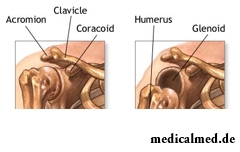





Dislocation

Dislocations represent the mutual shift of the joint ends of the bones which are jointed among themselves. Joint shift at dislocation – resistant, with restriction of physiological mobility and sharply expressed pain syndrome.
Types of dislocations
Dislocations of joints are subdivided into the following main types depending on the nature of their emergence:
Traumatic.
Arise, as a result of mechanical impact on a joint, for example, during the falling or blow. This type of dislocations, as a rule, is followed by gaps in a joint bag. Traumatic dislocations are often complicated by fractures of bones, infringement of soft tissues, damage of integuments, nerve terminations and sinews.
Inborn.
This type of dislocation of joints belongs to pathologies of development of a musculoskeletal system and arises at a pre-natal stage of fetation. Congenital dislocation of a hip is most widespread.
Pathological.
Pathological dislocations of joints arise as result of inflammatory processes and further destruction of the joint ends of bones, under the influence of such diseases as osteomyelitis, tuberculosis and so forth. Forecasts and tactics treatment first of all are under construction on therapy of a basic disease taking into account the greatest possible recovery of mobility of the affected joint.
Usual.
Formation of habitual dislocation is most characteristic of a shoulder joint. Habitual dislocation of a shoulder forms if after an injury immobilized fixing of a joint was insufficient on time. The short period of an immobilization leads to the fact that in an effect dislocation of a shoulder arises repeatedly as result of the slightest physical effort or the careless movement. For elimination of effects of habitual dislocation tactics of operational surgical intervention directed to normalization of a condition of the copular device usually is chosen.
Dislocation reasons
The origin of dislocations can carry as inborn (vnutriutrobno the forming hip dislocation), and the acquired character (an effect of an injury or inflammatory diseases of the fabrics surrounding a joint).
The following factors are the most common causes of dislocation of joints:
- falling or blow, with sharp contact of a joint with a firm surface, for example, falling with blow on an elbow causes shoulder dislocation;
- sharp and considerable reduction of muscles;
- physical impact on a joint or on the area adjoining to it;
- unnatural and strong straightening or bend of a joint.
Dislocation symptoms
 Treats the most common symptoms of dislocation:
Treats the most common symptoms of dislocation:
- at the time of an injury characteristic cotton is heard;
- around the injured joint hypostasis and swelling (the most common symptom of dislocation) is formed;
- sharp and strong morbidity;
- bruises;
- at damage of nerve terminations, decrease in sensitivity;
- mobility restriction;
- pricking and numbness;
- pale and cold integuments;
- visual deformation, etc.
Specific symptoms of dislocation differ from the place in which the joint is injured.
Shoulder dislocation
Dislocations of a shoulder belong to the most widespread types of dislocations of a traumatic origin (statistically - more than a half of all cases). This fact is explained by features of an anatomic structure of a shoulder joint: disproportionate a ratio of joint surfaces, insufficiently strong by nature front muscular department, considerable motive range in the different planes, the volume capsule of a joint and so forth.
Shoulder dislocation, as a rule, results from indirect influence, when falling on an elbow or a forearm, almost in hundred percent of cases is followed by a rupture of the capsule, sometimes with damage of a rotary cuff and a separation of a big humeral hillock (most often shoulder dislocation - at patients of advanced age).
Hip dislocation
Traumatic dislocation of a hip in the general statistics of dislocations is diagnosed rather seldom (no more than 7 percent of total number of cases). Ileal dislocation of a hip (85 percent), further – locking, sciatic and nadlonny dislocations of a hip is in the lead.
Subspecies of dislocations of a hip depending on the directed power impact on a head are classified as follows:
- ileal (posterosuperior);
- locking (anteroinferior);
- sciatic (zadnenizhniya);
- nadlonny (anterosuperior dislocation of a hip).
First aid at dislocation
 Fixing (providing an immovability) of an extremity in that provision which it adopted after an injury is necessary for rendering first aid to the victim at dislocation, overlaying of a cold compress to the place of the injured joint is obligatory.
Fixing (providing an immovability) of an extremity in that provision which it adopted after an injury is necessary for rendering first aid to the victim at dislocation, overlaying of a cold compress to the place of the injured joint is obligatory.
Attempts of independent reposition of a dislocated joint are inadmissible by no means as only the experienced doctor in the conditions of medical institution will be able precisely to establish whether dislocation is combined with changes or cracks of bones.
Most of women is capable to derive more pleasure from contemplation of the beautiful body in a mirror, than from sex. So, women, you aim at symmetry.

All like to sing. Small children with pleasure are engaged in a vocal, not especially thinking of hit in a melody. Adults most often...
Section: Articles about health
Extracorporal fertilization – one of the most modern methods of controlling with infertility. So far he already helped a significant amount of married couples to become happy parents. Usually to the EKO procedure difficult and very expensive, resort in those...
Section: Articles about health
At this plant there are a lot of names: tuberiferous sunflower, Jerusalem artichoke, solar root, earth pear. Contrary to popular belief, it is not an exotic plant at all. The wild girasol grows in a midland of Russia practically everywhere: at the edges of roads, to slopes of ravines, on heathlands. Also several cultural versions different from wild plants are removed by larger and juicy root crops....
Section: Articles about health
The dietology, as well as other sciences, does not stand still. Food stuffs are exposed to comprehensive study, and scientists receive new and...
Section: Articles about health
Each person supports all life a SARS about 200 times. The peak of incidence falls on cold season, but it is possible to get sick with a temperature and a pharyngalgia, and sometimes and very possibly, even during a heat. The reasons for development of catarrhal diseases exists множество:...
Section: Articles about health
Stroke (acute disorder of cerebral circulation) – one of the most widespread neurologic diseases. Annually in the world more than 6 million people die of this illness. From the survived patients about 80% become disabled people, and nearly a third from them needs afterwards permanent care. In fact, the stroke creates a situation at which a part of cells of a brain loses blood access, loses an opportunity to receive oxygen and nutrients, and perishes. As a result of a razviv...
Section: Articles about health
Helminthosis is one of the most widespread diseases. Statistically, with any species of helminths it is infected porridges...
Section: Articles about health
According to World Health Organization, every third inhabitant of Earth has excess weight, and every tenth has obesity. The reason of this phenomenon, according to specialists, roots in one not very comforting fact: most of people consume much...
Section: Articles about health
The varicosity has familiarly many, statistically, this disease more than a half of all adult population. As a rule, the varicosis affects preferential superficial vessels, and is shown by characteristic cosmetic defects. The deep vein thrombosis as this illness at the initial stages can imperceptibly proceed is represented much more dangerous, and in the started cases threatens with serious danger – thrombosis. This state, when the blood clot formed...
Section: Articles about health
The concept "gluten" (differently, a gluten) combines group of the proteins which are a part of rye, barley and wheat. For most of people упот...
Section: Articles about health
Each woman has preferences in the field of use of those goods which help us to look good, feel young and effective. Besides: selection process of favourite perfume, shampoo or decorative cosmetics already lifts a spirit...
Section: Articles about health
Among a set of the perfumery and cosmetic goods which are released today the special group is made by the means containing antibacterial components. Such types of gels, shampoos, soaps, creams, lotions and other products are positioned by manufacturers as a panacea from all diseases caused by pathogenic microorganisms. The unlimited and uncontrolled use of similar means becomes result of trustfulness of the buyers hypnotized by persuasive advertizing sometimes. Many spetsial...
Section: Articles about health
More than a half of the married couples which faced prostatitis – leave. The new broadcast "Female View of Prostatitis" will help to learn...
Section: Articles about health
Maternal milk is the best food for the newborn. It is the unique natural product containing an optimum set of nutrients, and which is best adapted in order that the baby normally developed and it was protected from harmful fa...
Section: Articles about health
Life expectancy in various regions of Earth is not identical. Social stability, economic wellbeing, availability and level of medical care, household comfort, literacy of the population in the field of respect for sanitary and hygienic norms and many other factors exert impact on it. However one parameter remains to the general almost for all countries of the world: women on average live for 7-10 years longer, than men. Today we will talk about the reasons of this phenomenon....
Section: Articles about health
Visit of doctors – business not the most pleasant, and many people do not hurry to undergo necessary planned inspections. Such behavior...
Section: Articles about health
What they, women? Beautiful, gentle, passionate and at the same time windy, gusty, and nervous. And what is stranger: have all these qualities of the woman at the same time. But here only the mood their time sharply changes on completely opposite: in the morning...
Section: Articles about health
Scientists have no unambiguous opinion on a proximate cause of emergence of a carcinoma cutaneum today. Only the factors promoting development of this illness are precisely established. Treat them: long impact on skin of ultraviolet rays, radiation exposure, thermal injuries, injuries of skin by aggressive chemicals (pitches, acids, alkalis, etc.), genetic predisposition (existence of malignant new growths of skin in the family anamnesis), at...
Section: Articles about health
In consciousness of our many compatriots idea that folk remedies if no more эфф strongly took roots...
Section: Articles about health
Quite large number of people adheres to the principles of vegetarian food. But how to be if in a family of vegetarians there are children? Whether it is possible to eat also it the same as to parents, or after all the children's organism is not adapted for the use only раст...
Section: Articles about health
Coffee - the tonic loved by many for the invigorating aroma and deep taste. Having the stimulating effect, coffee increases working capacity, promotes concentration of attention, fights against drowsiness and improves mood. Statistically, about 30% of inhabitants of the planet regularly use coffee, from them more than 8% are "coffee-achievers" - the persons using more than 3 cups of drink a day....
Section: Articles about health
Condition of lips (their morbidity, outward) – one of indicators of health of the person. Peeling, dryness, pallor, and also трещ...
Section: Articles about health
About 20% of the population of our planet have a hypertension (permanent increase in arterial pressure). This disease has an adverse effect on the standard of living, reduces working capacity, and in the absence of systematic treatment threatens with such complications as a heart attack...
Section: Articles about health
The medicine promptly develops, and the fact that else quite recently it seemed by miracle can now. We are not surprised any more to the fact that people with artificial joints and extremities can play sports, organ transplantation became a routine, and the latest cancer medicine allowed to achieve reduction of mortality in tens of times. Miracles of plastic surgery thanks to which people in 60 years are in the flower of beauty and freshness, too not a sensation any more....
Section: Articles about health
The winter swimming in open reservoirs called in our country by "winter swimming" – officially recognized sport and one of the ek...
Section: Articles about health
Statistically cystitis 25-30% of women up to 40 years have. With age this indicator raises, besides many do not get to statistics because do not see a doctor. The most sad that after the regular visits to doctors, long reception of antibiotics...
Section: Articles about health
It would seem, to buy drugs in Moscow does not make a problem – a drugstore, and not one, is available for each resident of the capital within walking distance. And, nevertheless, Internet drugstores become more popular – what it is possible to explain such phenomenon with? Actually there is a lot of reasons and if to formulate them it is short, then the most suitable word will be - "conveniently". We suggest to get acquainted in more detail with pluses and minuses of online drugstores that buying drugs, not to make the wrong choice....
Section: Articles about health
